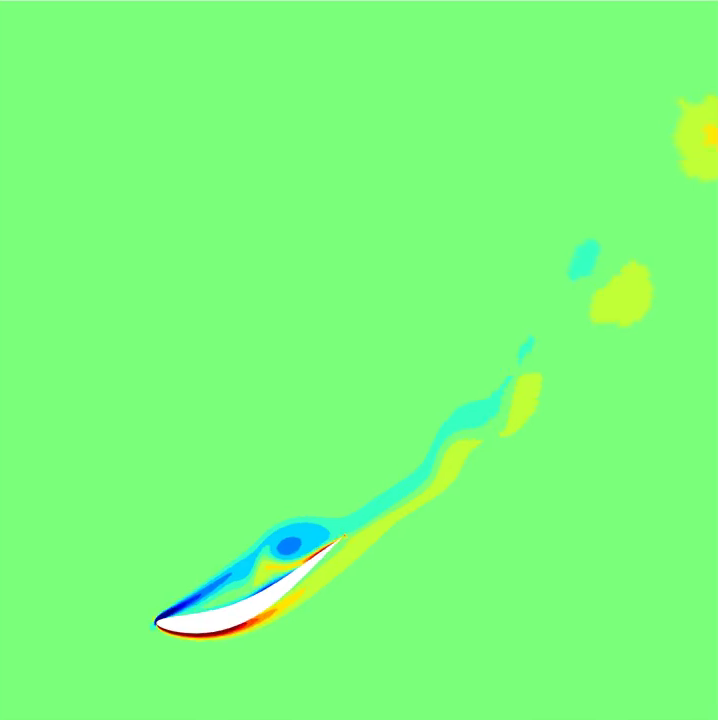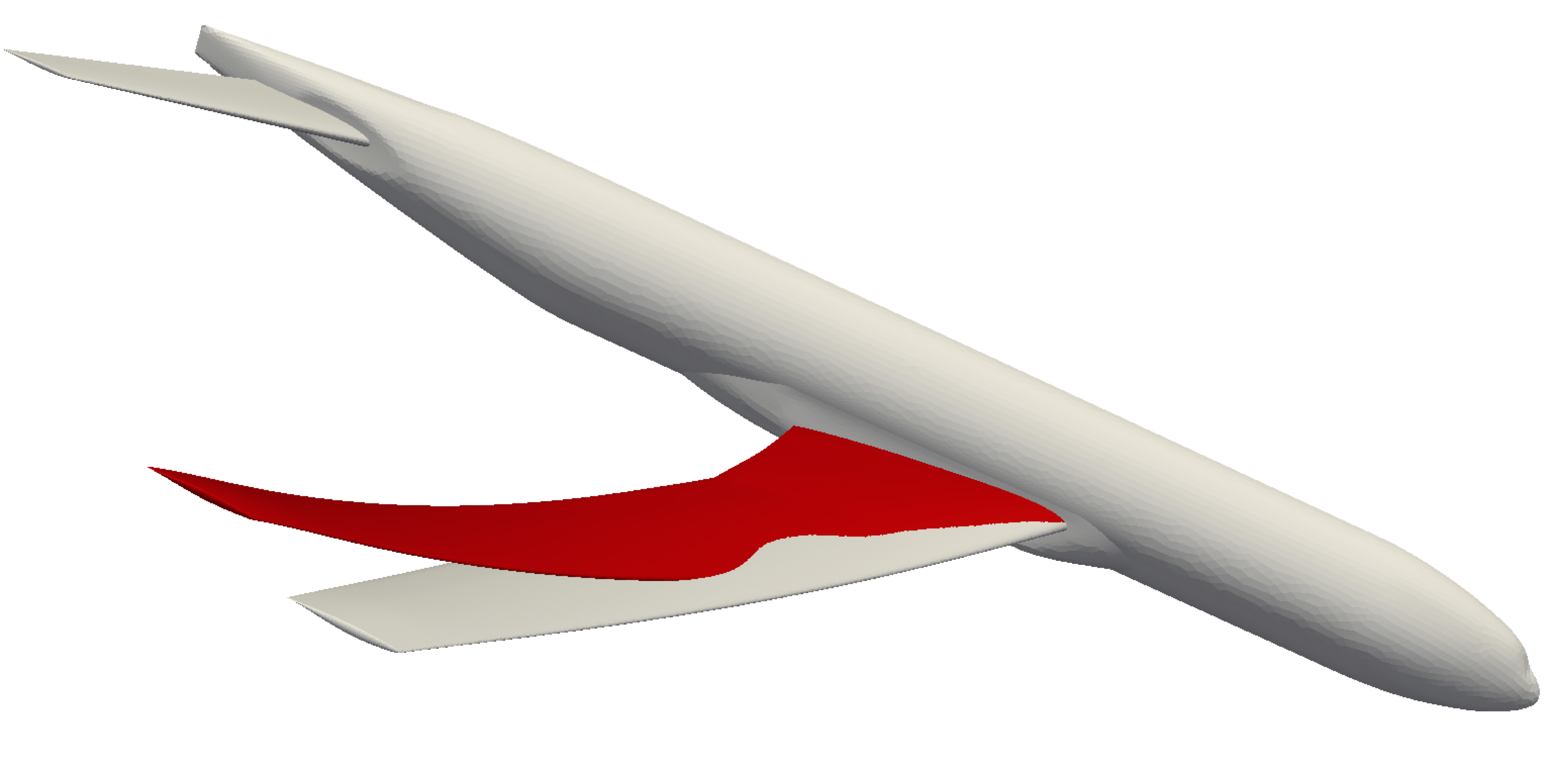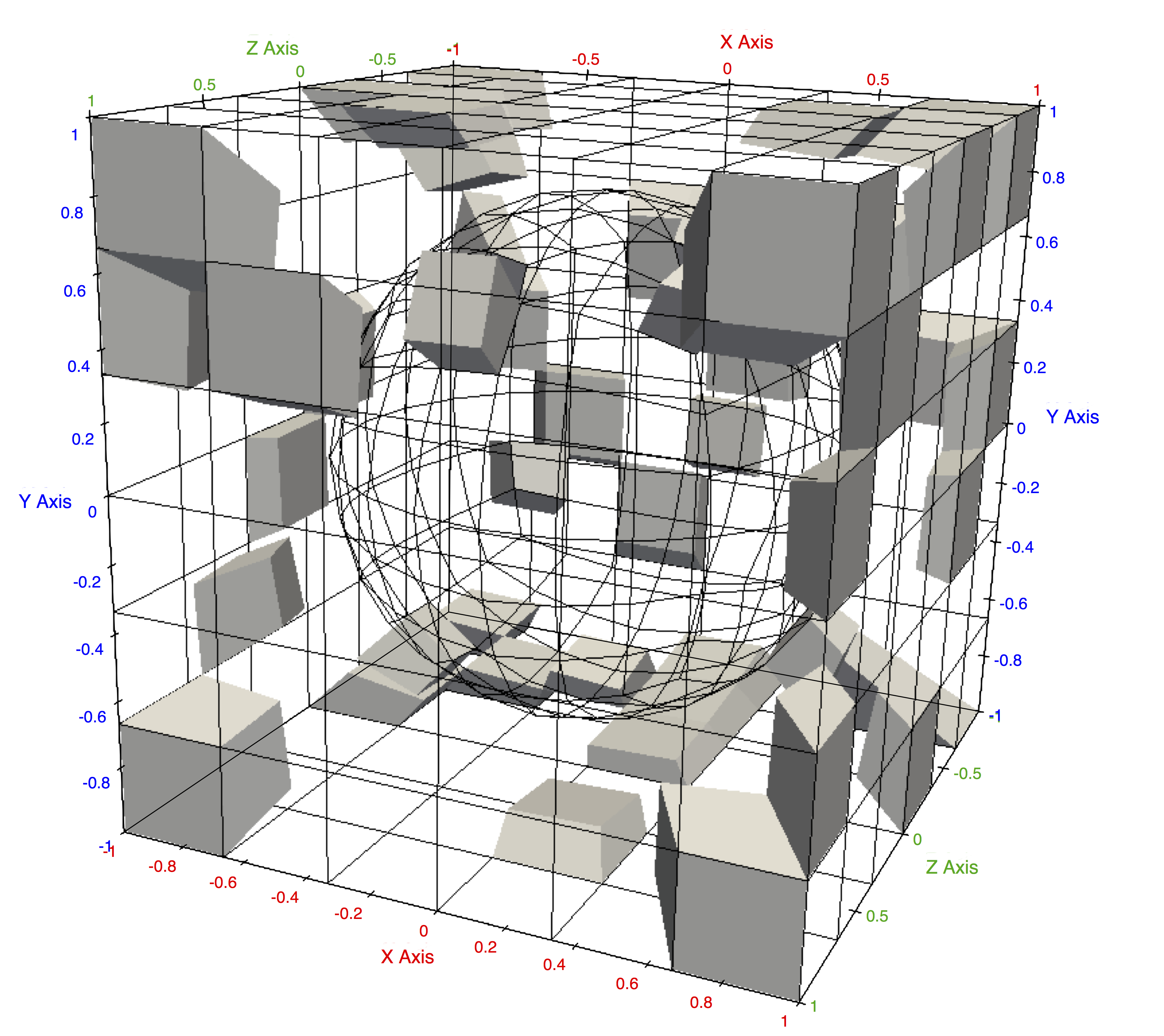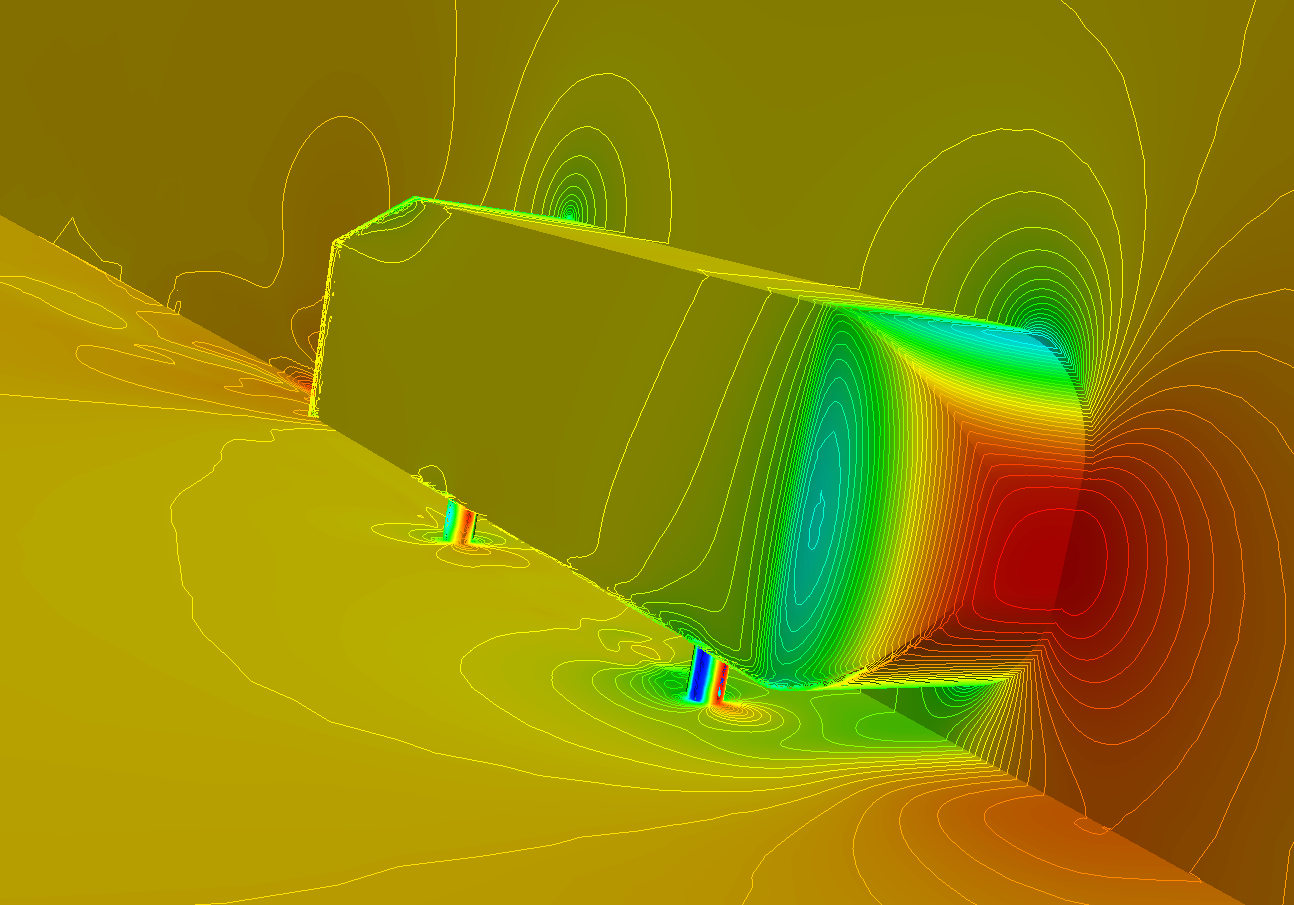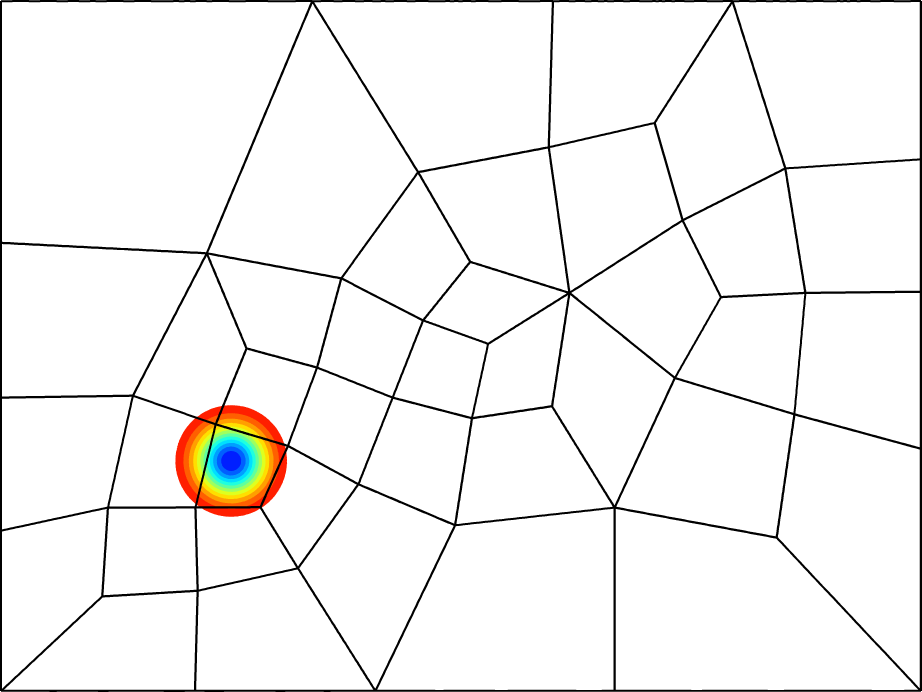
Research overview
High-order implicit shock tracking
Shock waves and other types of discontinuous or shape-gradient features commonly arise in critical applications in fields such as aerospace, astrophysics, combustion, and many more. Accurate resolution of these flow fields is a longstanding difficultly in computational science/engineering and usually requires extreme anisotropic mesh refinement and a large number of degrees of freedom. We developed a novel approach to approximate solutions to nonlinear conservation laws called High-Order Implicit Shock Tracking (HOIST). The method is based on a high-order DG discretization of the governing equations and automated alignment of elements with non-smooth flow features (shocks, contact discontinuities, head/tail of rarefactions). By aligning the mesh with the non-smooth features, they are perfectly represented by the DG basis and the smooth solutions away from these features are approximated with high-order accuracy. As such, the method is free of nonlinear instabilities (oscillations) without use of limiting or artificial viscosity. The key innovation that enables automatic alignment of the grid with flow features is re-casting the geometrically complex problem of generating a mesh that aligns with an unknown discontinuity surface as an optimization problem. The method begins with a grid that is agnostic to all flow features and solves the novel optimization problem to simultaneously determine the flow solution and optimal nodal coordinates of the grid that cause element faces to align with flow features. Thus, mesh alignment with shocks happens implicitly through the solution of the optimization problem; the only topological mesh modification used is element removal via edge collapse, which is simple and well-defined for simplex element in any dimension.
Optimal convergence rates for shocked flows. The HOIST method recovers optimal (p+1) convergence rates for solutions with discontinuities, as demonstrated by flow through an area variation (quasi-1D Euler equations), whereas traditional shock capturing methods based on artificial viscosity struggle to achieve first-order convergence.
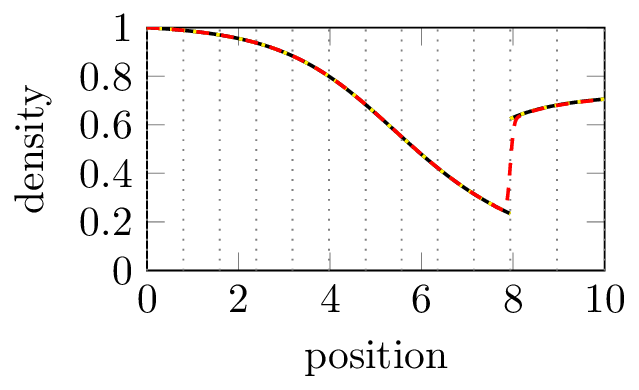
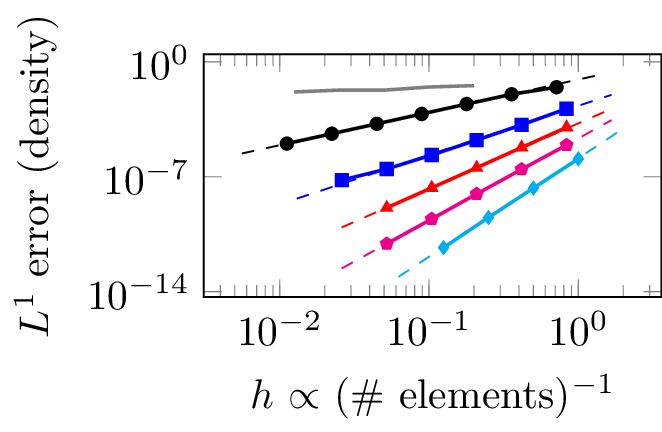
Left: Density of flow through an area variation: exact solution (black), shock capturing with 50 quartic elements (red dashed), and implicit shock tracking with 10 quartic elements (yellow dotted); edges of the converged shock tracking mesh are shown in vertical dotted lines. Right: Mesh convergence of the shock capturing method based on artificial viscosity with p=4 elements (solid gray) and implicit shock tracking with elements of degree p=1,...,5 (solid). The dashed lines indicate the optimal convergence rate for each polynomial degree (p+1).
High accuracy per degree of freedom for flows with non-smooth features. The HOIST method produces accurate solutions on extremely coarse, high-order meshes, even more so than popular fifth-order WENO methods.
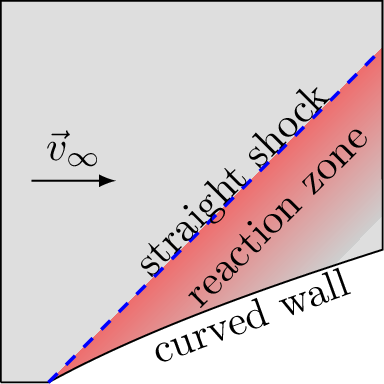
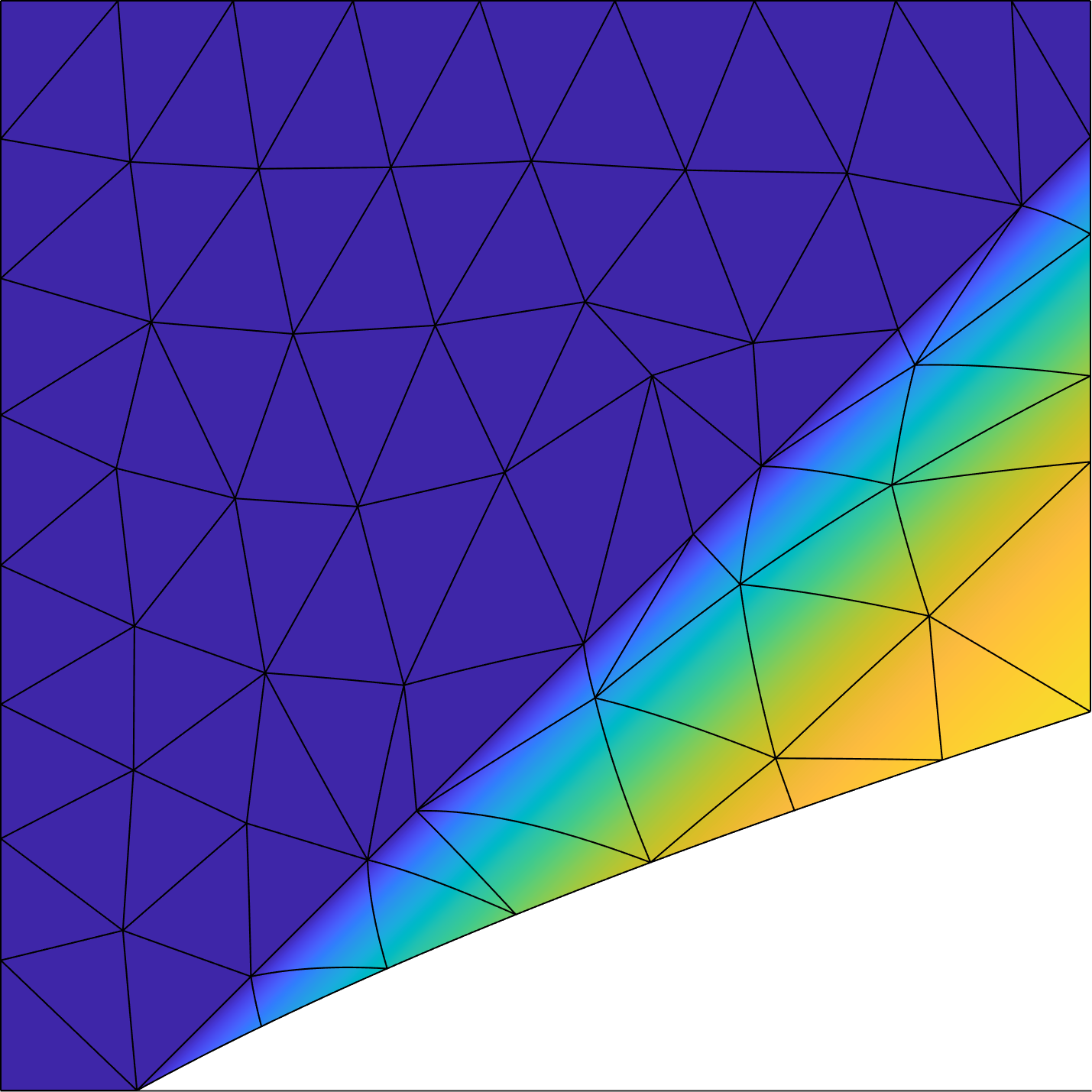
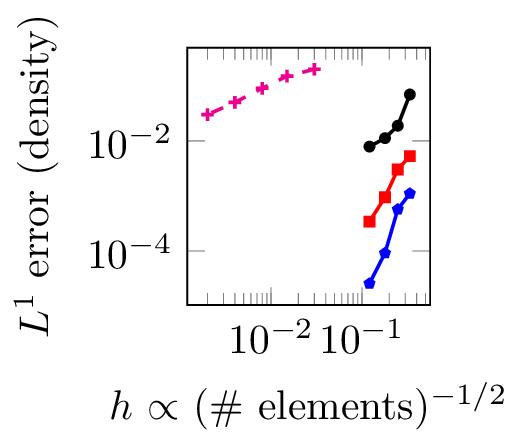
Left: Schematic of reacting flow problem in [Powers, Aslam; 2006]. Middle: HOIST solution (reaction progress) with only 100 cubic elements. Right: Mesh convergence study of fifth-order WENO finite difference scheme (dashed grey +) [Powers, Aslam; 2006] and HOIST with elements of degree p=1 (solid black circles), p=2 (solid red squares), p=3 (solid blue pentagons).
Automatic alignment of a generic mesh with complex shock surfaces. The novel optimization formulation and solver lead to automated alignment of the mesh with complex shock/contact surfaces in two and three dimensions starting from a generic mesh (generated without knowledge of shock/contact surfaces).
Convergence history (mesh and solution) of HOIST solver for space-time Burgers' equation (accelerating shock) with p=1 (left), p=2 (middle), and p=3 (right) elements.
Convergence history (mesh and solution) of HOIST solver for space-time Burgers' equation (shock formation and merge) with p=3 elements. The initially smooth solution eventually forms discontinuities that propagate toward one another and merge; the HOIST method tracks both the shock formation and merging events with the computational mesh.
Convergence history (mesh and solution) of HOIST solver for space-time 1D Euler equations (Sod shock tube) with p=2 elements. The solution possesses a generalized triple point from which the shock wave, contact discontinuity, and rarefaction emanate. All features, including the head and tail of the rarefaction (continuous solution, discontinuity in derivative), are all tracked at convergence.
Convergence history (mesh and solution) of HOIST solver for Mach 2 (supersonic) flow over a diamond in a tunnel with 201 quadratic elements. The solution possesses curved and intersecting shocks, all of which are tracked with the high-order mesh.
Convergence history (mesh and solution) of HOIST solver for Mach 5 (hypersonic) flow through a scramjet with 2447 quadratic elements. The solution possesses shocks that reflect off boundaries, intersect with one another to form triple points, and interact with expansions lead to curved shocks; all these features are tracked with the high-order mesh.
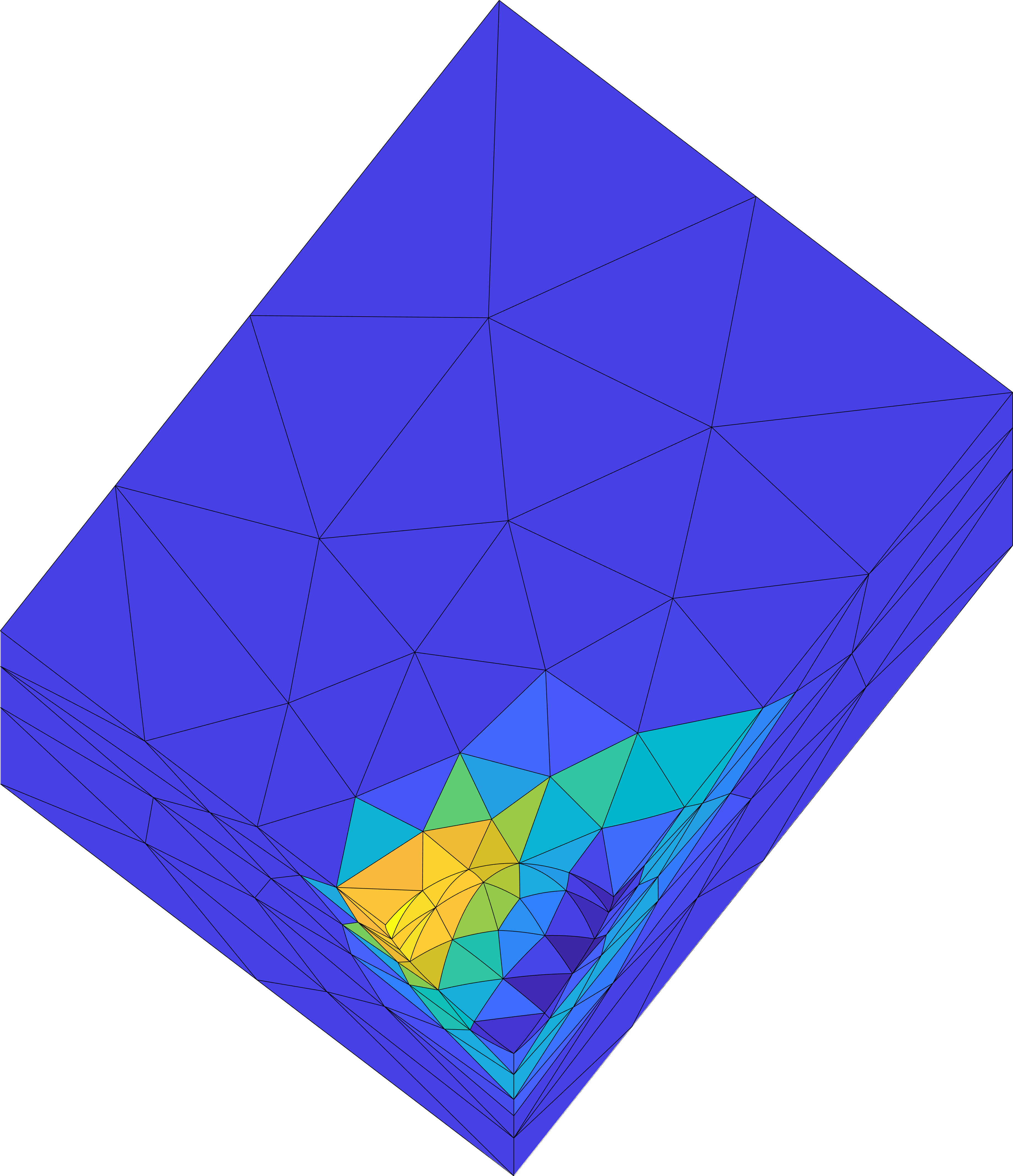
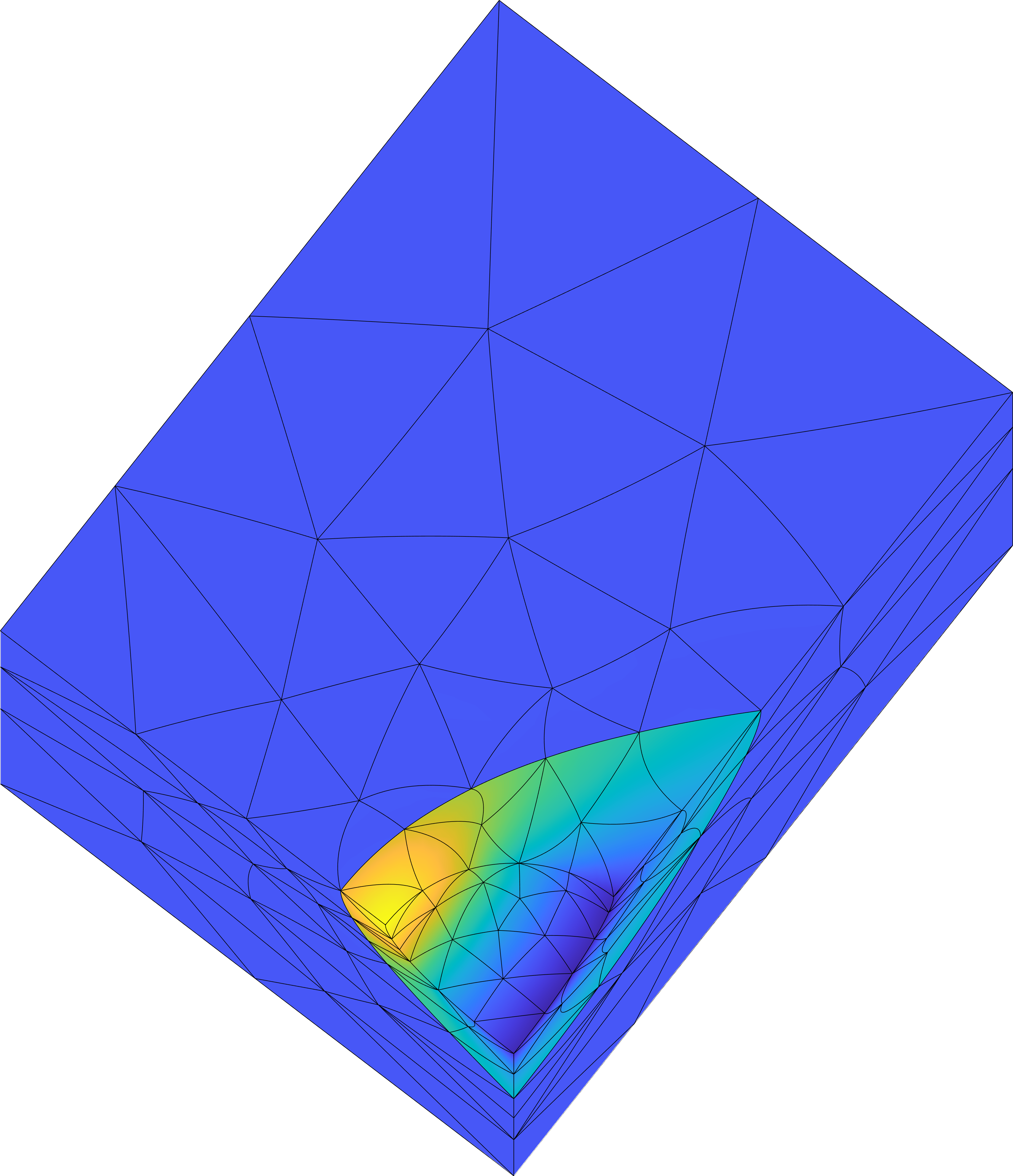
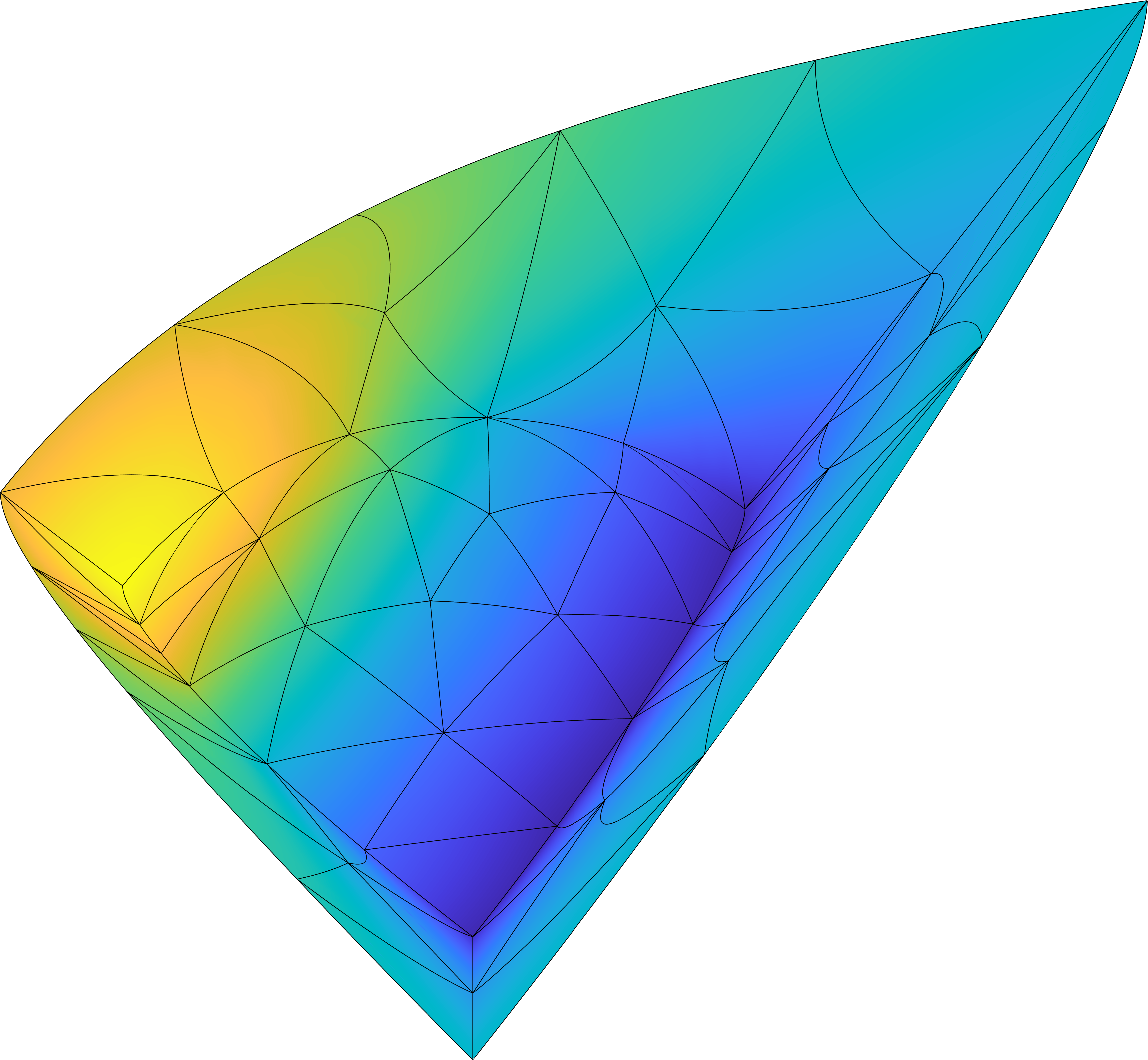
The HOIST method (491 quadratic elements) applied to Mach 2 flow over a sphere, including the solution and mesh used to initialize the iterations (left), the converged solution (middle), and a zoom of the converged solution between the bow shock and sphere surface (right), which shows automated shock alignment of HOIST works robustly in three dimensions.
Journal papers
-
V. Zucatti and M. J. Zahr, “Model reduction of convection-dominated viscous conservation laws using implicit feature tracking and landmark image registration,” Journal of Computational Physics, in review 2025. [ bib | arxiv ]
-
J. M. Kaufmann and M. J. Zahr, “Symmetric, optimization-based, cross-element compatible nodal distributions for high-order finite elements,” Communications in Applied Mathematics and Computational Science, vol. 20, pp. 119--146, April 2025. [ bib | DOI | arxiv ]
-
A. Thakur and M. J. Zahr, “Neural network-based Godunov corrections for approximate Riemann solvers using bi-fidelity learning,” Communications in Applied Mathematics and Computational Science, accepted 2025. [ bib | arxiv ]
-
C. J. Naudet, B. Taylor, and M. J. Zahr, “A sharp-interface discontinuous Galerkin method for simulation of two-phase flow of real gases based on implicit shock tracking,” Journal of Computational Physics, in review 2025. [ bib | arxiv ]
-
H. Dong, M. Yano, T. Huang, and M. J. Zahr, “An rp-adaptive method for accurate resolution of shock-dominated viscous flow based on implicit shock tracking,” Journal of Computational Physics, in review 2025. [ bib | arxiv ]
-
A. Perez Reyes and M. J. Zahr, “An implicit shock tracking method for simulation of shock-dominated flow over complex domains using mesh-based parametrizations,” Journal of Computational Physics, in review 2025. [ bib | arxiv ]
-
J. Vandergrift and M. J. Zahr, “Preconditioned iterative solvers for constrained high-order implicit shock tracking methods,” Journal of Computational Physics, vol. 514, p. 113234, October 2024. [ bib | arxiv ]
-
C. J. Naudet and M. J. Zahr, “A space-time high-order implicit shock tracking method for shock-dominated unsteady flows,” Journal of Computational Physics, vol. 501, p. 112792, March 2024. [ bib | arxiv ]
-
T. Huang, C. J. Naudet, and M. J. Zahr, “High-order implicit shock tracking boundary conditions for flows with parametrized shocks,” Journal of Computational Physics, vol. 495, p. 112517, December 2023. [ bib | arxiv ]
-
M. Mirhoseini and M. J. Zahr, “Accelerated solutions of convection-dominated partial differential equations using implicit feature tracking and empirical quadrature,” International Journal for Numerical Methods in Fluids, vol. 96, pp. 102--124, September 2023. [ bib | arxiv ]
-
M. Mirhoseini and M. J. Zahr, “Model reduction of convection-dominated partial differential equations via optimization-based implicit feature tracking,” Journal of Computational Physics, vol. 473, p. 111739, January 2023. [ bib | DOI | link | arxiv ]
-
T. Huang and M. J. Zahr, “A robust, high-order implicit shock tracking method for simulation of complex, high-speed flows,” Journal of Computational Physics, vol. 454, p. 110981, April 2022. [ bib | DOI | arxiv ]
-
A. Shi, P.-O. Persson, and M. J. Zahr, “Implicit shock tracking for unsteady flows by the method of lines,” Journal of Computational Physics, vol. 454, p. 110906, April 2022. [ bib | arxiv ]
-
M. J. Zahr and J. M. Powers, “High-order resolution of multidimensional compressible reactive flow using implicit shock tracking,” AIAA Journal, vol. 59, no. 1, pp. 150--164, 2021. [ bib | DOI | link ]
-
M. J. Zahr, A. Shi, and P.-O. Persson, “Implicit shock tracking using an optimization-based high-order discontinuous Galerkin method,” Journal of Computational Physics, vol. 410, p. 109385, 2020. [ bib | DOI | link | arxiv ]
-
M. J. Zahr and P.-O. Persson, “An optimization-based approach for high-order accurate discretization of conservation laws with discontinuous solutions,” Journal of Computational Physics, vol. 365, pp. 105 -- 134, 2018. [ bib | DOI | link | arxiv | paper ]
Conference papers
-
H. Dong, A. Perez Reyes, and M. J. Zahr, “A p-adaptive high-order implicit shock tracking method for compressible, inviscid flows,” in AIAA Science and Technology Forum and Exposition (SciTech2025), (Orlando, Florida), American Institute of Aeronautics and Astronautics, AIAA Paper 2025-1568, 1/6/2025 -- 1/10/2025. [ bib | link ]
-
T. Huang, M. J. Zahr, K. R. Holst, A. Baker, J. Freels, P. Batten, N. Bachchan, J. B. Maeng, T. C. Fisher, J. Park, S. Jee, and W. J. White, “High-Fidelity CFD Verification Workshop 2024 Summary: Shock-Dominated Flows,” in AIAA Aviation Forum and Exposition (Aviation 2024), (Las Vegas, Nevada), American Institute of Aeronautics and Astronautics, AIAA Paper 2024-3695, 7/29/2024 -- 8/2/2024. [ bib | link ]
-
C. J. Naudet, B. Taylor, and M. J. Zahr, “High-order implicit shock tracking for finite-source spherical blast waves,” in AIAA Aviation Forum and Exposition (Aviation 2023), (San Diego, California), American Institute of Aeronautics and Astronautics, AIAA Paper 2023-3863, 6/12/2023 -- 6/16/2023. [ bib | link ]
-
T. Huang and M. J. Zahr, “High-order implicit shock tracking boundary conditions for supersonic flow over a smoothed rectangle,” in AIAA Science and Technology Forum and Exposition (SciTech2023), (National Harbor, Maryland), American Institute of Aeronautics and Astronautics, AIAA Paper 2023-1977, 1/23/2023 -- 1/27/2023. [ bib | link ]
-
K. Holst, C. Kim, and M. J. Zahr, “High-Fidelity CFD Verification Workshop 2024: Shock-Dominated Flows,” in AIAA Science and Technology Forum and Exposition (SciTech2023), (National Harbor, Maryland), American Institute of Aeronautics and Astronautics, AIAA Paper 2023-1242, 1/23/2023 -- 1/27/2023. [ bib | link ]
-
O. Rasheed, T. Huang, and M. J. Zahr, “High-order implicit shock tracking for a supersonic biplane airfoil,” in AIAA Aviation Forum and Exposition (Aviation 2022), (Chicago, Illinois), American Institute of Aeronautics and Astronautics, AIAA Paper 2022-4082, 6/27/2022 -- 7/1/2022. [ bib ]
-
T. Huang and M. J. Zahr, “High-order implicit shock tracking with targeted mesh optimization and PDE-based smoothing,” in AIAA Aviation Forum and Exposition (Aviation 2021), (Washington, D.C.), American Institute of Aeronautics and Astronautics, AIAA Paper 2021-2710, 6/7/2021 -- 6/11/2021. [ bib | link ]
-
M. J. Zahr and P.-O. Persson, “An r-adaptive, high-order discontinuous Galerkin method for flows with attached shocks,” in AIAA Science and Technology Forum and Exposition (SciTech2020), (Orlando, Florida), American Institute of Aeronautics and Astronautics, AIAA Paper 2020-0537, 1/6/2020 -- 1/10/2020. [ bib | link ]
-
A. Shi, P.-O. Persson, and M. J. Zahr, “An optimization-based discontinuous Galerkin approach for high-order accurate shock tracking with guaranteed mesh quality,” in AIAA Science and Technology Forum and Exposition (SciTech2019), (San Diego, California), American Institute of Aeronautics and Astronautics, AIAA Paper 2019-1151, 1/7/2019 -- 1/11/2019. [ bib | paper | link ]
-
M. J. Zahr and P.-O. Persson, “An optimization-based discontinuous Galerkin approach for high-order accurate shock tracking,” in AIAA Science and Technology Forum and Exposition (SciTech2018), (Kissimmee, Florida), American Institute of Aeronautics and Astronautics, AIAA Paper 2018-0063, 1/8/2018 -- 1/12/2018. [ bib | paper | link ]
Talks
-
R. A. M. Braga and M. J. Zahr, “A hybrid shock fitting-capturing method for high-speed flows,” in 18th U.S. National Congress on Computational Mechanics (USNCCM18), (Chicago, IL), 7/20/2025 -- 7/24/2025. [ bib ]
-
H. Dong, T. Huang, M. Yano, and M. J. Zahr, “A p-adaptive implicit shock tracking method for high-speed viscous flows,” in 18th U.S. National Congress on Computational Mechanics (USNCCM18), (Chicago, IL), 7/20/2025 -- 7/24/2025. [ bib ]
-
A. Perez Reyes and M. J. Zahr, “Mesh-based boundary preserving parametrization for implicit shock tracking of shock dominated flows,” in 18th U.S. National Congress on Computational Mechanics (USNCCM18), (Chicago, IL), 7/20/2025 -- 7/24/2025. [ bib ]
-
C. J. Naudet and M. J. Zahr, “High-order implicit shock tracking for multi-material shocked flows,” in 18th U.S. National Congress on Computational Mechanics (USNCCM18), (Chicago, IL), 7/20/2025 -- 7/24/2025. [ bib ]
-
C. J. Naudet and M. J. Zahr, “High-order implicit shock tracking for multi-material shocked flows high-order implicit shock tracking for multi-material shocked flows,” in International Conference on Spectral and High Order Methods (ICOSAHOM) 2025, (Montreal, Quebec, Canada), 7/13/2025 -- 7/18/2025. [ bib ]
-
M. J. Zahr, “High-order implicit shock tracking for shock-dominated flows,” in Mathematics Department Seminar, Portland State University (Host: Will Pazner), (Portland, Oregon), Portland State University, 3/14/2025. [ bib | slides ]
-
M. J. Zahr, “Implicit Shock Tracking - a PDE-constrained optimization approach to accurate resolution of high-speed viscous flows,” in 2025 SIAM Conference on Computational Science and Engineering (CSE25), (Fort Worth, Texas), 3/3/2025 -- 3/7/2025. [ bib ]
-
H. Dong, A. Perez Reyes, and M. J. Zahr, “A p-adaptive high-order implicit shock tracking method for compressible, inviscid flows,” in Proc. of the AIAA Science and Technology Forum and Exposition (SciTech2025), (Orlando, Florida), American Institute of Aeronautics and Astronautics, 1/6/2025 -- 1/10/2025. [ bib ]
-
M. J. Zahr, “High-order implicit shock tracking for high-speed flows,” in Emerging Trends in Computational Fluid Dynamics (Jameson-Kim-Wang Symposium), (Stanford, California), 12/5/2024 -- 12/7/2024. [ bib ]
-
M. J. Zahr, “Model reduction with implicit feature tracking to accelerate simulation of hypersonic flow,” in 2024 AFOSR/ONR MURI Review, (Washington, D.C.), Air Force Office of Scientific Research, 12/3/2024. [ bib ]
-
C. Naudet and M. J. Zahr, “High-order implicit shock tracking for time-dependent flows,” in Research Training Group (RTG) in Numerical Mathematics and Scientific Computing (NASC) Annual Workshop, (Houston, Texas), 10/4/2024 -- 10/5/2024. [ bib ]
-
M. J. Zahr, “Improved blast simulations using high-order implicit shock tracking,” in AFOSR Dynamic Materials and Interaction Program Review, (Oxon Hill, Maryland), Air Force Office of Scientific Research, 8/19/2024 -- 8/23/2024. [ bib ]
-
M. J. Zahr, “Adaptive model reduction for shock-dominated flows to enable many-query computational physics,” in AFOSR Computational Mathematics Program Review, (Hybrid Event; Washington, D.C.), Air Force Office of Scientific Research, 8/12/2024 -- 8/16/2024. [ bib ]
-
M. J. Zahr, “Improved simulation of hypersonic flows using high-order implicit shock tracking,” in AFOSR/ONR/HVSI Annual High-Speed Aerodynamics Portfolio Review, (Hybrid Event; Minneapolis, Minnesota), Office of Naval Research, 8/5/2024 -- 8/9/2024. [ bib ]
-
T. Huang, M. J. Zahr, K. R. Holst, A. Baker, J. Freels, P. Batten, N. Bachchan, J. B. Maeng, T. C. Fisher, J. Park, S. Jee, and W. J. White, “High-Fidelity CFD Verification Workshop 2024 Summary: Shock-Dominated Flows,” in Proc. of the AIAA Aviation Forum and Exposition (Aviation 2024), (Las Vegas, Nevada), American Institute of Aeronautics and Astronautics, 7/29/2024 -- 8/2/2024. [ bib ]
-
A. Thakur and M. J. Zahr, “Exploring Riemann solvers, machine learning surrogates, and shock tracking in hyperbolic PDE systems,” in 16th World Congress on Computational Mechanics (WCCM-XVI) and 4th Pan American Congress on Computational Mechanicsc (PANACM-IV), (Vancouver, British Columbia, Canada), 7/21/2024 -- 7/26/2024. [ bib ]
-
A. Perez Reyes and M. J. Zahr, “Implicit shock tracking for high-speed flows with attached shocks,” in 16th World Congress on Computational Mechanics (WCCM-XVI) and 4th Pan American Congress on Computational Mechanicsc (PANACM-IV), (Vancouver, British Columbia, Canada), 7/21/2024 -- 7/26/2024. [ bib ]
-
H. Dong and M. J. Zahr, “A p-adaptive implicit shock tracking method for high-speed viscous flows,” in 16th World Congress on Computational Mechanics (WCCM-XVI) and 4th Pan American Congress on Computational Mechanicsc (PANACM-IV), (Vancouver, British Columbia, Canada), 7/21/2024 -- 7/26/2024. [ bib ]
-
M. J. Zahr, “Adaptive model reduction for analysis and optimization of shock-dominated flows,” in 2023 AFOSR/ONR MURI Review, (Washington, D.C.), Air Force Office of Scientific Research, 12/13/2023. [ bib ]
-
M. J. Zahr, “High-order implicit shock tracking for shock-dominated flows,” in Center for Computational and Applied Mathematics Seminar, Purdue University (Host: Xiangxiong Zhang), (West Lafayette, Indiana), Purdue University, 10/30/2023. [ bib | slides ]
-
M. J. Zahr, “Improved blast simulations using high-order implicit shock tracking,” in AFOSR Dynamic Materials and Interaction Program Review, (Hybrid Event; Alexandria, Virginia), Air Force Office of Scientific Research, 8/21/2023 -- 8/25/2023. [ bib ]
-
M. J. Zahr, “Adaptive model reduction for shock-dominated flows to enable many-query computational physics,” in AFOSR Computational Mathematics Program Review, (Hybrid Event; Washington, D.C.), Air Force Office of Scientific Research, 8/7/2023 -- 8/11/2023. [ bib ]
-
M. J. Zahr, “Improved simulation of hypersonic flows using high-order implicit shock tracking,” in AFOSR/ONR/HVSI Annual High-Speed Aerodynamics Portfolio Review, (Hybrid Event; College Park, Maryland), Office of Naval Research, 7/24/2023 -- 7/28/2023. [ bib ]
-
T. Huang and M. J. Zahr, “Simulation of shock-dominated flows using high-order implicit shock tracking,” in 17th U. S. National Congress on Computational Mechanics (USNCCM17), (Albuquerque, New Mexico), 7/23/2023 -- 7/27/2023. [ bib ]
-
C. J. Naudet and M. J. Zahr, “High-order implicit shock tracking for time-dependent flows,” in 17th U. S. National Congress on Computational Mechanics (USNCCM17), (Albuquerque, New Mexico), 7/23/2023 -- 7/27/2023. [ bib ]
-
C. J. Naudet, B. Taylor, and M. J. Zahr, “High-order implicit shock tracking for finite-source spherical blast waves,” in Proc. of the AIAA Aviation Forum and Exposition (Aviation 2023), (San Diego, California), American Institute of Aeronautics and Astronautics, 6/12/2023 -- 6/16/2023. [ bib ]
-
M. J. Zahr, “Optimization-based implicit shock tracking for unsteady flows,” in SIAM Conference on Optimization, (Seattle, Washington), 5/31/2023 -- 6/3/2023. [ bib ]
-
M. J. Zahr, “High-order implicit shock tracking for shock-dominated flows,” in 22nd Computational Fluids Conference (CFC2023), (Cannes, France), 4/25/2023 -- 4/28/2023. [ bib | slides ]
-
C. J. Naudet and M. J. Zahr, “High-order implicit shock tracking for unsteady flows,” in 22nd Computational Fluids Conference (CFC2023), (Cannes, France), 4/25/2023 -- 4/28/2023. [ bib ]
-
M. J. Zahr, “Adaptive model reduction for high-speed flows,” in Computational Challenges and Emerging Tools (DDEW03) (Host: Isaac Newton Institute for Mathematical Sciences), (Cambridge, United Kingdom), 4/24/2023 -- 4/27/2023. [ bib ]
-
M. J. Zahr, “Simulation of shock-dominated flows using high-order implicit shock tracking,” in Applied Mechanics Seminar, Indian Institute of Technology (IIT) Delhi (Host: Prateek Gupta), (Virtual Event; Delhi, India), IIT Delhi, 4/14/2023. [ bib ]
-
M. J. Zahr, “Adaptive model reduction for shock-dominated flows,” in SIAM Conference on Computational Science and Engineering, (Amsterdam, Netherlands), 2/27/2023 -- 3/3/2023. [ bib ]
-
M. J. Zahr, “High-order implicit shock tracking for shock-dominated flows,” in Numerical Analysis and Scientific Computing Seminar, University of Waterloo (Host: David Del Rey Fernandez), (Virtual Event; Waterloo, Ontario), University of Waterloo, 2/7/2023. [ bib | slides ]
-
T. Wen and M. J. Zahr, “An augmented Lagrangian trust-region method to accelerate equality-constrained shape optimization problems using model hyperreduction,” in Proc. of the AIAA Science and Technology Forum and Exposition (SciTech2023), (National Harbor, Maryland), American Institute of Aeronautics and Astronautics, 1/23/2023 -- 1/27/2023. [ bib ]
-
T. Huang and M. J. Zahr, “High-order implicit shock tracking boundary conditions for supersonic flow over a smoothed rectangle,” in Proc. of the AIAA Science and Technology Forum and Exposition (SciTech2023), (National Harbor, Maryland), American Institute of Aeronautics and Astronautics, 1/23/2023 -- 1/27/2023. [ bib ]
-
K. Holst, C. Kim, and M. J. Zahr, “High-Fidelity CFD Verification Workshop 2024: Shock-Dominated Flows,” in Proc. of the AIAA Science and Technology Forum and Exposition (SciTech2023), (National Harbor, Maryland), American Institute of Aeronautics and Astronautics, 1/23/2023 -- 1/27/2023. [ bib ]
-
M. J. Zahr, “High-order implicit shock tracking for shock-dominated flows,” in Fluid Dynamics Research Consortium (FDRC), The Pennsylvania State University (Host: David Williams), (State College, Pennsylvania), Penn State University, 12/8/2022. [ bib | slides ]
-
M. J. Zahr, “Adaptive model reduction for analysis and optimization of shock-dominated flows,” in 2022 AFOSR/ONR MURI Review, (Washington, D.C.), Air Force Office of Scientific Research, 11/30/2022. [ bib ]
-
M. J. Zahr, “High-order, optimization-based computational fluid dynamics,” in SIAM Student Chapter Lecture, University of Notre Dame, (Notre Dame, Indiana), University of Notre Dame, 11/16/2022. [ bib | slides ]
-
M. J. Zahr, “Simulation of shock-dominated flows using high-order implicit shock tracking,” in Eulerian Code Group, Los Alamos National Laboratory (Host: Lauren Green), (Virtual Event; Los Alamos, New Mexico), Los Alamos National Laboratory, 11/14/2022. [ bib | slides ]
-
M. Mirhoseini and M. J. Zahr, “Model reduction of convection-dominated partial differential equations via optimization-based implicit feature tracking,” in Model Reduction and Surrogate Modeling (MORE), (Berlin, Germany), 9/19/2022 -- 9/23/2022. [ bib ]
-
V. Zucatti and M. J. Zahr, “POD-based adaptive model reduction to accelerate computational fluid dynamics,” in Model Reduction and Surrogate Modeling (MORE), (Berlin, Germany), 9/19/2022 -- 9/23/2022. [ bib ]
-
E. Bursch, M. J. Zahr, and R. McClarren, “Radiation hydrodynamics modeling with high-order implicit shock tracking,” in 10th International Conference on Numerical Methods for Multi-Material Fluid Flow (MultiMat 2022), (Zurich, Switzerland), 8/22/2022 -- 8/26/2022. [ bib ]
-
T. Huang, C. J. Naudet, and M. J. Zahr, “High-order implicit shock tracking for flows with interfaces,” in 10th International Conference on Numerical Methods for Multi-Material Fluid Flow (MultiMat 2022), (Zurich, Switzerland), 8/22/2022 -- 8/26/2022. [ bib ]
-
M. J. Zahr, “Adaptive model reduction for shock-dominated flows to enable many-query computational physics,” in AFOSR Computational Mathematics Program Review, (Hybrid Event; Washington, D.C.), Air Force Office of Scientific Research, 8/15/2022 -- 8/19/2022. [ bib ]
-
C. J. Naudet and M. J. Zahr, “High-order implicit shock tracking for time-dependent flows,” in 15th World Congress on Computational Mechanics (WCCM-XV) and 8th Asian Pacific Congress on Computational Mechanics (APCOM-VIII), (Virtual Event; Yokohama, Japan), 7/31/2022 -- 8/5/2022. [ bib ]
-
M. Mirhoseini and M. J. Zahr, “Model reduction of convection-dominated partial differential equations via optimization-based implicit feature tracking,” in 15th World Congress on Computational Mechanics (WCCM-XV) and 8th Asian Pacific Congress on Computational Mechanics (APCOM-VIII), (Virtual Event; Yokohama, Japan), 7/31/2022 -- 8/5/2022. [ bib ]
-
T. Huang and M. J. Zahr, “High-order implicit shock tracking for compressible, viscous flows,” in 15th World Congress on Computational Mechanics (WCCM-XV) and 8th Asian Pacific Congress on Computational Mechanics (APCOM-VIII), (Virtual Event; Yokohama, Japan), 7/31/2022 -- 8/5/2022. [ bib ]
-
M. J. Zahr, “High-order implicit shock tracking for high-speed flows,” in Alvarez Fellow Seminar Series, Lawrence Berkeley National Laboratory (Host: Julianne Mueller), (Virtual Event: Berkeley, California), Lawrence Berkeley National Laboratory, 7/26/2022. [ bib | slides ]
-
M. J. Zahr, “Improved simulation of hypersonic flows using high-order implicit shock tracking,” in AFOSR/ONR/HVSI Annual High-Speed Aerodynamics Portfolio Review, (Hybrid Event; Caltech, California), Office of Naval Research, 7/18/2022 -- 7/22/2022. [ bib ]
-
T. Huang, C. J. Naudet, and M. J. Zahr, “High-order implicit shock tracking,” in North American High Order Methods Conference (NAHOMCon), (San Diego, California), 7/18/2022 -- 7/19/2022. [ bib ]
-
O. Rasheed, T. Huang, and M. J. Zahr, “High-order implicit shock tracking for a supersonic biplane airfoil,” in Proc. of the AIAA Aviation Forum and Exposition (Aviation 2022), (Chicago, Illinois), American Institute of Aeronautics and Astronautics, 6/27/2022 -- 7/1/2022. [ bib ]
-
M. J. Zahr, T. Huang, and C. J. Naudet, “High-order implicit shock tracking for high-speed flows,” in Engineering Mechanics Institute Conference 2022 (EMI 2022), (Baltimore, Maryland), 5/30/2022 -- 6/3/2022. [ bib ]
-
M. J. Zahr, “Model reduction of convection-dominated flows using implicit tracking feature tracking,” in Reduced-Order Models at Work: Industry and Medicine (Host: Inria Bordeaux), (Bordeaux, France), 3/30/2022 -- 4/1/2022. [ bib ]
-
M. J. Zahr, “Improved blast simulations using high-order implicit shock tracking,” in AFOSR Dynamic Materials and Interaction Kickoff, (Virtual Event), Air Force Office of Scientific Research, 2/1/2022. [ bib ]
-
M. J. Zahr, “Unsteady supersonic/hypersonic test suite,” in High Fidelity CFD Workshop 2022, (San Diego, California), 1/8/2022 -- 1/9/2022. [ bib ]
-
M. J. Zahr, “Adaptive model order reduction to accelerate hypersonic flow simulations,” in 2021 AFOSR/ONR MURI Review, (Washington, D.C.), Air Force Office of Scientific Research, 12/8/2021. [ bib ]
-
M. J. Zahr, “High-order and reduced-order methods for improved engineering analysis and design,” in Large Scale Structural Systems Early-Career Colloquium, USACM (Host: Pablo Seleson), (Virtual Event), United States Association for Computational Mechanics, 11/3/2021. [ bib | slides ]
-
M. J. Zahr, “At the intersection of computational science and aerospace engineering,” in Mechanical, Aerospace & Biomedical Engineering Seminar, University of Tennessee, Knoxville (Host: Devina Sanjaya), (Virtual Event; Knoxville, Tennessee), University of Tennessee, Knoxville, 9/1/2021. [ bib | slides ]
-
M. J. Zahr, “Model reduction of convection-dominated partial differential equations via optimization-based implicit feature tracking,” in Centre for Computational Science and Engineering Seminar, University of Toronto (Host: Masayuki Yano), (Virtual Event: Toronto, Canada), University of Toronto, 8/23/2021. [ bib | slides ]
-
M. J. Zahr, “Adaptive model reduction for shock-dominated flows to enable many-query computational physics,” in AFOSR Computational Mathematics Program Review, (Virtual Event; Washington, D.C.), Air Force Office of Scientific Research, 8/9/2021. [ bib ]
-
T. Huang and M. J. Zahr, “High-order implicit shock tracking: robust solvers and applications,” in 16th U.S. National Congress on Computational Mechanics (USNCCM16), (Chicago, Illinois), 7/25/2021 -- 7/29/2021. [ bib ]
-
A. Shi, P.-O. Persson, and M. J. Zahr, “Implicit shock tracking and the method of lines for shock-dominated, unsteady flows,” in 16th U.S. National Congress on Computational Mechanics (USNCCM16), (Chicago, Illinois), 7/25/2021 -- 7/29/2021. [ bib ]
-
M. Mirhoseini and M. J. Zahr, “Model reduction of convection-dominated partial differential equations via optimization-based implicit feature tracking,” in 16th U.S. National Congress on Computational Mechanics (USNCCM16), (Virtual Event; Chicago, IL), 7/25/2021 -- 7/29/2021. [ bib ]
-
M. J. Zahr, “Implicit shock tracking using an optimization-based high-order discontinuous Galerkin method,” in International Conference on Spectral and High Order Methods (ICOSAHOM) 2020/2021, (Virtual Event; Vienna, Austria), 7/12/2021 -- 7/16/2021. [ bib ]
-
M. J. Zahr, “Model reduction of convection-dominated partial differential equations via optimization-based implicit feature tracking,” in Data-Driven Physical Simulations Seminar, Lawrence Livermore National Laboratory (Host: Youngsoo Choi), (Virtual Event; Livermore, California), Lawrence Livermore National Laboratory, 6/24/2021. [ bib ]
-
M. J. Zahr, “Model reduction of convection-dominated partial differential equations via optimization-based implicit feature tracking,” in 10th International Conference on Adaptive Modeling and Simulation (ADMOS), (Virtual Event; Gothenburg, Sweden), 6/21/2021 -- 6/23/2021. [ bib ]
-
T. Huang and M. J. Zahr, “High-order implicit shock tracking with targeted mesh optimization and PDE-based smoothing,” in Proc. of the AIAA Aviation Forum and Exposition (Aviation 2021), (Washington, D.C.), American Institute of Aeronautics and Astronautics, 6/7/2021 -- 6/11/2021. [ bib ]
-
M. J. Zahr, “Robust high-order implicit shock tracking solver for high-speed flows,” in Computational Hypersonics Research Lab Seminar, University of Minnesota (Host: Graham Candler), (Virtual Event; Minneapolis, Minnesota), University of Minnesota, 5/18/2021. [ bib | slides ]
-
M. J. Zahr, “Integrating computational physics and numerical optimization to address challenges in computational science, engineering, and medicine,” in Applied and Computational Mathematics and Statistics Seminar, University of Notre Dame (Host: Alan Lindsay), (Virtual Event; Notre Dame, Indiana), University of Notre Dame, 4/8/2021. [ bib | slides ]
-
A. Shi, P.-O. Persson, and M. J. Zahr, “Implicit shock tracking and the method of lines for shock-dominated, unsteady flows,” in SIAM Conference on Computational Science and Engineering, (Virtual Event; Fort Worth, Texas), 3/1/2021 -- 3/5/2021. [ bib ]
-
T. Huang, C. Naudet, and M. J. Zahr, “Robust high-order implicit shock tracking solver for complex high-speed flows,” in SIAM Conference on Computational Science and Engineering, (Virtual Event; Fort Worth, Texas), 3/1/2021 -- 3/5/2021. [ bib ]
-
M. J. Zahr and J. M. Powers, “Accurate methods for computing high mach number reactive flow,” in Turbulence Analysis and Simulation Center Seminar (Host: Daniel Tortorelli), (Virtual Event; Livermore, California), Lawrence Livermore National Laboratory, 6/24/2020. [ bib ]
-
M. J. Zahr and P.-O. Persson, “An r-adaptive, high-order discontinuous Galerkin method for flows with attached shocks,” in Proc. of the AIAA Science and Technology Forum and Exposition (SciTech2020), (Orlando, Florida), American Institute of Aeronautics and Astronautics, 1/6/2020 -- 1/10/2020. [ bib ]
-
M. J. Zahr, “Integrating computational physics and numerical optimization to address challenges in computational science, engineering, and medicine,” in Data Sciences Seminar, Johns Hopkins University (Host: Fei Lu), (Baltimore, Maryland), Johns Hopkins University, 12/4/2019. [ bib ]
-
M. J. Zahr and P.-O. Persson, “An optimization-based approach for high-order accurate discretization of conservation laws with discontinuous solutions,” in 15th U.S. National Congress on Computational Mechanics (USNCCM15), (Austin, Texas), 7/28/2019 -- 8/2/2019. [ bib ]
-
M. J. Zahr and P.-O. Persson, “An optimization-based discontinuous Galerkin approach for high-order accurate shock tracking,” in North American High Order Methods Conference (NAHOMCon), (San Diego, California), 6/2/2019 -- 6/5/2019. [ bib ]
-
M. J. Zahr and P.-O. Persson, “An optimization-based discontinuous Galerkin approach for high-order accurate shock tracking,” in Finite Elements in Fluids, (Chicago, Illinois), 3/31/2019 -- 4/3/2019. [ bib ]
-
M. J. Zahr, “Integrated computational physics and numerical optimization,” in Center for Informatics and Computational Science Seminar, Univerity of Notre Dame (Host: Nicholas Zabaras), (Notre Dame, Indiana), University of Notre Dame, 3/6/2019. [ bib ]
-
M. J. Zahr and P.-O. Persson, “An optimization-based discontinuous Galerkin approach for high-order shock tracking,” in SIAM Conference on Computational Science and Engineering, (Spokane, Washington), 2/25/2019 -- 3/1/2019. [ bib ]
-
A. Shi, P.-O. Persson, and M. J. Zahr, “An optimization-based discontinuous Galerkin approach for high-order accurate shock tracking with guaranteed mesh quality,” in Proc. of the AIAA Science and Technology Forum and Exposition (SciTech2019), (San Diego, California), American Institute of Aeronautics and Astronautics, 1/7/2019 -- 1/11/2019. [ bib ]
-
M. J. Zahr, “Integrated computational physics and numerical optimization,” in Program in Applied Mathematics Colloquium, University of Arizona (Host: Matthias Morzfeld), (Tuscon, Arizona), University of Arizona, 9/21/2018. [ bib | slides ]
-
M. J. Zahr, “Integrated computational physics and numerical optimization,” in Applied Mathematics Seminar, UC Berkeley (Host: Per-Olof Persson), (Berkeley, California), University of California, Berkeley, 9/6/2018. [ bib | slides ]
-
M. J. Zahr and P.-O. Persson, “An optimization-based discontinuous galerkin approach for high-order accurate shock tracking,” in 6th European Conference on Computational Mechanics (ECCM 6) and 7th European Conference on Computational Fluid Dynamics (ECFD 7), (Glasgow, Scotland, United Kingdom), 6/11/2018 -- 6/15/2018. [ bib ]
-
M. J. Zahr, “Optimization-based computational physics and high-order methods: from optimized analysis to design and data assimilation,” in Aerospace and Ocean Engineering Seminar, Virginia Tech (Host: Kevin Wang), (Blacksburg, Virginia), Virginia Polytechnic Institute and State University, 4/2/2018. [ bib ]
-
M. J. Zahr and P.-O. Persson, “An optimization-based discontinuous Galerkin approach for high-order accurate shock tracking,” in 5th International Workshop on High-Order CFD Methods, (Kissimmee, Florida), 1/8/2018 -- 1/12/2018. [ bib ]
-
M. J. Zahr and P.-O. Persson, “An optimization-based discontinuous Galerkin approach for high-order accurate shock tracking,” in AIAA Science and Technology Forum and Exposition (SciTech2018), (Kissimmee, Florida), American Institute of Aeronautics and Astronautics, 1/8/2018 -- 1/12/2018. [ bib ]
-
M. J. Zahr, “Optimization-based computational physics and high-order methods: from optimized analysis to design and data assimilation,” in LBNL CRD Postdoc Seminar Series, (Berkeley, California), Lawrence Berkeley National Laboratory, 9/18/2017. [ bib | slides ]
Posters
-
H. Dong, T. Huang, M. Yano, and M. J. Zahr, “A p-adaptive implicit shock tracking method for high-speed viscous flows,” in 18th U.S. National Congress on Computational Mechanics (USNCCM18), (Chicago, IL), 7/20/2025 -- 7/24/2025. [ bib ]
-
M. J. Zahr, “Improved simulation of shock-dominated flows using high-order implicit shock tracking,” in ASME 2024 - International Mechanical Engineering Congress and Exposition, (Portland, Oregon), 11/17/2024 -- 11/21/2024. [ bib ]
-
H. Dong and M. J. Zahr, “A p-adaptive implicith shock tracking method for high-speed viscous flows,” in North American High Order Methods Conference (NAHOMCon), (Dartmouth, New Hampshire), 6/17/2024 -- 6/19/2024. [ bib ]
-
A. Perez Reyes and M. J. Zahr, “Implicit shock tracking for high-speed flows with attached shocks,” in North American High Order Methods Conference (NAHOMCon), (Dartmouth, New Hampshire), 6/17/2024 -- 6/19/2024. [ bib ]
-
C. J. Naudet and M. J. Zahr, “High-order implicit shock tracking for time-dependent flows,” in North American High Order Methods Conference (NAHOMCon), (Dartmouth, New Hampshire), 6/17/2024 -- 6/19/2024. [ bib ]
-
T. Huang, C. Naudet, and M. J. Zahr, “High-order implicit shock tracking for high-speed flows,” in SIAM Conference on Computational Science and Engineering, (Virtual Event; Fort Worth, Texas), 3/1/2021 -- 3/5/2021. [ bib | poster ]
-
A. Kiran and M. J. Zahr, “An optimization-based discontinuous Galerkin approach for high-order accurate shock tracking,” in LBNL Summer Student Program Poster Session, (Berkeley, California), 8/2/2018. [ bib | poster ]
-
M. J. Zahr and P.-O. Persson, “Adjoint-based optimization, uncertainty quantification, and data assimilation of multiphysics systems using high-order numerical discretizations,” in DOE ASCR Applied Mathematics PI Meeting, (Washington D.C.), 9/11/2017 -- 9/12/2017. [ bib | poster ]
